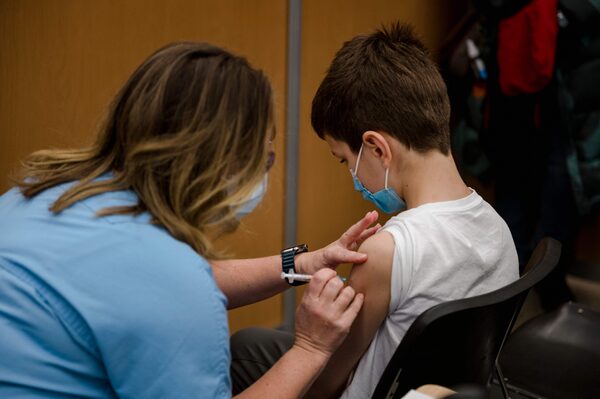
A child, 11, receives the Pfizer-BioNTech COVID-19 vaccine for children in Montreal on Nov. 24.ANDREJ IVANOV/AFP/Getty Images
On Nov. 19, Health Canada gave its stamp of approval to something parents had been waiting for: a COVID-19 vaccine for children ages 5 to 11. Within a week, Canada had received enough pediatric doses to deliver a first shot to every one of the newly eligible 2.9 million kids.
There was an initial surge of shots – but it was short-lived. For example, Quebec’s goal was a first dose for all kids by Christmas; the province achieved barely half that. On a national basis, in the first month of pediatric vaccinations, Canada got shots into the arms of only 39.5 per cent of children. By comparison, when 12- to 17-year-olds became eligible for jabs in late May, the first-shot rate was 63.5 per cent at the one-month mark.
And thanks to the arrival of Omicron, attention has increasingly shifted to the need for booster shots for adults. The slow-starting kids’ vaccination campaign spent the past few weeks slowing, and slowing some more.
On a national basis, the first-shot rate for kids aged 5 to 11 was 45.6 per cent on Jan. 1.
That’s halfway to the goal, which sounds pretty good. But almost from the start, the number of shots given has been falling.
In early December, as parents rushed to inoculate their kids, the total number of children vaccinated rose more than 14 percentage points in a week. It was up more than 11 points the second week of December, then eight points the following week.
But over the last two weeks of 2021, just 3 per cent of young kids got vaccinated per week. The curve is dropping faster, and sooner, than for previous ages. Peter Juni, scientific director of Ontario’s COVID-19 Science Table, last week called the trend “alarming.”
And there hasn’t been a postholiday improvement. Ontario’s latest figures show 46.7 per cent of five- to 11-year-olds have had a first dose, up three points from a week earlier. In Alberta, as of Jan. 6, first jabs had been received by 38 per cent of kids, up likewise from 35.2 per cent on Jan. 1.
Some parents may worry about adverse reactions to vaccinations, but they appear to be extremely rare; Alberta’s data show they are even more rare for kids than adults.
Others believe that COVID-19 isn’t dangerous for kids, so vaccinations aren’t needed. And it’s true that, while kids aged 11 and under represent about 12 per cent of the Canadian population, only 1,343 have been hospitalized by the virus over the past two years – 1.4 per cent of Canada’s pandemic hospitalizations.
However, almost 270,000 children 11 and under have tested positive – in line with their percentage of the population. With Omicron’s novelty and transmissibility, public-health officials aren’t sure what it will mean for children. Kids hopefully will continue to largely skirt serious illness, but that’s uncertain. There are also the risks of infected kids transmitting to older people.
Vaccines for kids are safe, effective – and not in short supply. The Pfizer pediatric vaccine, with a dosage one-third of the adult version, is available across Canada. As of Jan. 6, Ottawa had delivered 5.8 million doses. That’s enough to give two shots to every Canadian child between the ages of 5 and 11.
The challenge is getting those shots into arms. It can be done, as is clear from the relatively high vaccine uptake among all other age groups, including older children.
Newfoundland and Labrador has been the leader in vaccinating kids 5 to 11 – 70 per cent have their first jab. The province put a concerted effort into the campaign, including letters about safety to all parents, and availability of shots in schools. In Toronto, the city is making a second push in its “Team Toronto Kids” campaign, first launched in late November. It includes city-run mass vaccination sites, with activities for kids.
Making it easy and convenient to get a shot was a big part of getting jabs into so many arms last year. The percentage of Canadians who are vaccine hostile, as opposed to hesitant or uncertain or busy, is small. More than 90 per cent of Canadians over the age of 12 have had at least one shot. That includes more than 87 per cent of those aged 12 to 17.
All of which suggests that what’s holding up Canada’s pediatric vaccination campaign isn’t reluctance on the part of parents, but disorganization on the part of governments. Do better.
Keep your Opinions sharp and informed. Get the Opinion newsletter. Sign up today.